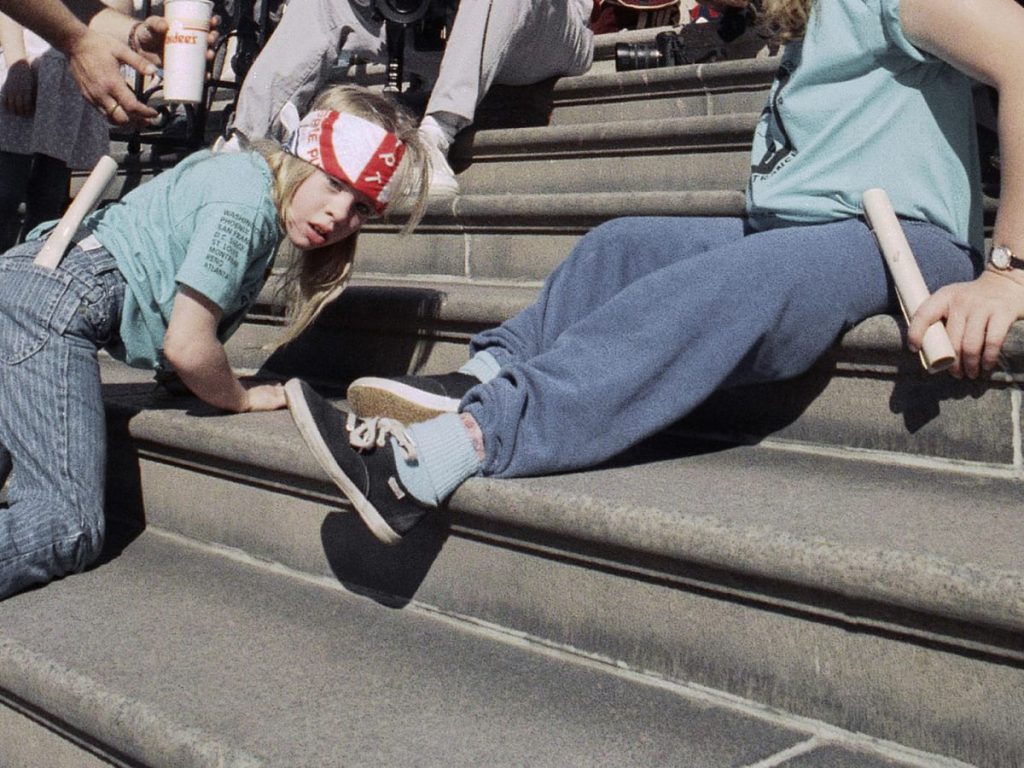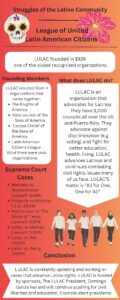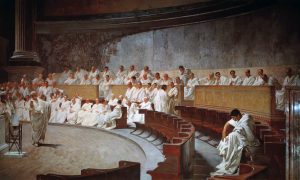The atmosphere compressed down as the sun’s heat baked the exposed concrete of the steps. That heat only served to push Jennifer further up the steps alongside her fellow crawlers. Willing her body to move up each step of the Capitol building was the only thing on her mind. Jennifer Keelan-Chaffins was intent on making sure the politicians inside that building understood and saw what the barriers that stood in their way really meant for them. No amount of concrete obstacles or formations were going to keep her from demonstrating this. To Jennifer, the signing of the Americans with Disabilities Act was not a matter of convenience; it was a matter of survival and of being able to participate in society with dignity. The ADA meant finally being able to have access to the things the rest of America’s non-disabled people take for granted. On one of the hottest days in March, Americans of all ages, races, genders, and backgrounds headed for the Capitol building. March 12, 1990 was a perfect culmination of circumstances.
Part of the groundwork that laid the foundation for the writing of the ADA was section 504 of the Rehabilitation Act. This was the first time in history that disabled people’s civil rights were included in legislation. Section 504 states that organizations and employers cannot discriminate against disabled people from being able to access services and program benefits. However, this addition of the 504 was hard fought for by disabled activists that organized and demonstrated their own sit-ins and protests.1 From the beginning, disabled people have been present in the fight for their own right to exist publicly in society. Along with Section 504, disabled Americans also fought for the right to work, for deinstitutionalization, and for their right to live independently. All of these moments in disabled American history converged and led up to the Americans with Disabilities Act.2

The ADA was introduced in the 1980s as the first civil rights legislation that was created with and for disabled people in mind. One of the main goals of the ADA was mandating accessible buildings and transit for people with disabilities. Prior to the ADA, busses and subway systems had no way for people with mobility aids to access them without climbing out of their chairs and lifting themselves and their aids up and down each step and ledge. Busses had no wheelchair lifts, subways had no elevators, parking lots had no disability parking, doorways were too narrow for wheelchair access, sidewalks lacked curb cuts, and buildings lacked accessible ramps. Although the legislation was introduced in the 1980s, it had taken almost a decade of waiting around for something to happen, because the bill had not been able to pass into legislation.3 Disabled people had to take things into their own hands. Thousands of individuals from various disability communities headed to the Capitol’s west entrance of the National Mall holding up signs urging for the ADA to be signed.4 Among these signs was the iconic disabled American flag, with stars depicting the disabled symbol. Many prominent disability activist groups were in attendance, like ADAPT (Americans Disabled for Attendant Programs Today). ADAPT stood in direct opposition to the main reason why the signing of the ADA was being stalled: the House Committee on Public Works and Transportation. Politicians argued that the ADA was too complicated and too expensive to adopt.5
People in wheelchairs and people using canes and crutches and other mobility aids shouted and marched. Family and allies of the disabled community stood alongside them in their efforts to get things moving at the Capitol. As they headed down Pennsylvania Avenue, they shouted, “What do we want? The ADA! When do we want it? Now!” and, “The people united will never be defeated!”6 Sweat dripped down their faces and their clothes stuck to their bodies, but the heat of their march was no match for the heat of March.
Upon arriving at the base of the Capitol steps, protestors literally stood in opposition against all that they were fighting against: the lack of accessibility in America. The Capitol building had no accessible access, just steps that seemed to tower over the protestors. Among the crowd of protestors sat Jennifer Keelan-Chaffins. Born with cerebral palsy and an already experienced activist at age eight, she was not deterred by the steps that stood in her way. Like her fellow protestors, Jennifer tightly held onto a pamphlet that was intended to be given to a politician in the effort to convince them to be in favor of the bill. Jennifer thought back to her experiences as a disabled student at school and how she was excluded from school classrooms and not allowed to attend certain schools.7 Most schools segregated disabled students entirely from the general classroom and their buildings often lacked accessible access. She remembered that her school back home did not even let disabled students eat in the cafeteria. Disabled people were to be hidden away from society. This served to feed her determination to get the ADA signed into law.

After a speech from a politician in favor of the ADA at the protest, Jennifer watched as her fellow protestors slid out of their chairs to the ground and began crawling to the steps. Many protestors needed help from friends and family to lift themselves up each grueling step, while others had to take long breaks. Some chose to stay back in their chairs and cheer on the crawlers. But this was nothing new for them as they faced these barriers daily all across America. As one of the only disabled children in attendance, Jennifer viscerally wanted to participate not only for herself, but for all the disabled kids that could not be there.8 “I need to climb those steps!” she said to her mother. And so she too slid out of her wheelchair and crawled to the base of those monstrous 78 steps.9
Upon making it to the first step, Jennifer placed her palms on the flat concrete and began to lift her body. The concrete, scorched from the sun, was practically steaming. After successfully climbing a few steps on her own, cameramen began to swarm Jennifer as she was the youngest person climbing the steps and others offered to give her water. Jennifer mostly paid them no mind except for the times she needed to take a break and accepted the water offered to her. Jennifer remembers that it seemed like fifty people were offering her water. Determined to make it to the top of those steps, she ascended each step, one at a time. Every step up was a struggle as her muscles strained and her body struggled to maneuver over the obstacles. Skin scraping against hot concrete and her bandana soaked with sweat, she continued her climb. Gritting her teeth, she shouted, “I’ll take all night if I have to!”10 True to her word, Jennifer never gave up her climb of the concrete mountain. She reached the top with her fellow protestors cheering her on and telling her, “You can do it! You made it to the top of the mountain!” Embraced by her mother, Jennifer knew there was no way they could be ignored by those politicians now.

That day, disabled people forced their fellow Americans to truly see them. The protestors showed America and the politicians inside the Capitol what disabled Americans had to do everyday just to simply travel to the store or to work. Jennifer and her fellow protestors succeeded in getting the attention of the politicians inside the Capitol. June 26, 1990, President George H.W. Bush finally signed the long awaited Americans with Disabilities Act.11 While it was the President that signed the act, it was the protestors that America had to thank. It is said that the image of Jennifer climbing the Capitol steps is what pushed the politicians over the edge to finally stop debating and actually agree to sign the Americans with Disabilities Act into law. The curb ramps, disability parking, bus wheelchair lifts, braille on elevators and signs, even the closed captioning on our videos and movies, and so much more that we take for granted today are all thanks to the ADA.
However, there are still issues that disabled Americans face today. For instance, disabled individuals still lack access to many buildings and transit even though the ADA was signed and many Americans with invisible disabilities face barriers that were not addressed by the ADA. Jennifer, today, says that the ADA is a floor for disability rights, not a ceiling and that there is still much work to be done. But if it was not for people like Jennifer Keelan-Chaffins, who had to fight for their right to exist openly, freely, and equally in society, we would still be living in the same world from thirty years ago. Today, March 12, 1990 is known as the Capitol Crawl and is credited as the pivotal moment that led to the signing of the ADA.
- “NowThis News, Commemorating 30 Years of the Americans with Disabilities Act,” video file, 10:58, YouTube, posted by NowThis, July 26, 2020, https://www.youtube.com/watch?v=MQafuiLGP7g&t=28s. ↵
- Renee A. Middleton, Carolyn W. Rollins, and Debra A. Harley, “The Historical and Political Context of the Civil Rights of Persons With Disabilities: A Multicultural Perspective for Counselors,” Journal of Multicultural Counseling & Development 27, no. 2 (April 1999): 105. ↵
- “NowThis News, Commemorating 30 Years of the Americans with Disabilities Act,” video file, 10:58, YouTube, posted by NowThis, July 26, 2020, https://www.youtube.com/watch?v=MQafuiLGP7g&t=28s. ↵
- “March 12, 1990: Disability Rights Activists Make ‘Capitol Crawl’ for the ADA,” Zinn Education Project, accessed April 17, 2021, https://www.zinnedproject.org/news/tdih/capitol-crawl-for-ADA/. ↵
- ABC News, “On 30th Anniversary of Disability Civil Rights Protest, Advocates Push for More,” ABC News, accessed April 17, 2021,https://abcnews.go.com/US/30th-anniversary-disability-civil-rights-protest-advocates-push/story?id=69491417. ↵
- “NowThis News, Commemorating 30 Years of the Americans with Disabilities Act,” video file, 10:58, YouTube, posted by NowThis, July 26, 2020, https://www.youtube.com/watch?v=MQafuiLGP7g&t=28s. ↵
- It’s Our Story, “Jennifer Keelan, 08 of 12: Climbing the Capitol Steps for ADA,” video file, 4:25, YouTube, posted by It’s Our Story, July 21, 2010, https://www.youtube.com/watch?v=kU9cDyqvH-,,. ↵
- It’s Our Story, “Jennifer Keelan, 08 of 12: Climbing the Capitol Steps for ADA,” video file, 4:25, YouTube, posted by It’s Our Story, July 21, 2010, https://www.youtube.com/watch?v=kU9cDyqvH-,,. ↵
- ABC News, “On 30th Anniversary of Disability Civil Rights Protest, Advocates Push for More,” ABC News, accessed April 17, 2021,https://abcnews.go.com/US/30th-anniversary-disability-civil-rights-protest-advocates-push/story?id=69491417. ↵
- It’s Our Story, “Jennifer Keelan, 08 of 12: Climbing the Capitol Steps for ADA,” video file, 4:25, YouTube, posted by It’s Our Story, July 21, 2010, https://www.youtube.com/watch?v=kU9cDyqvH-,,. ↵
- “March 12, 1990: Disability Rights Activists Make ‘Capitol Crawl’ for the ADA,” Zinn Education Project, accessed April 17, 2021,https://www.zinnedproject.org/news/tdih/capitol-crawl-for-ADA/. ↵



58 comments
Maria Fernanda Guerrero
Oh wow! The style of your writing was powerful. This story is impressive. I was not too familiar with disability rights so thank you for this information. Jennifer is a courageous and resilient individual who didn’t even let her disability stand in the way of getting her voice heard. I could only imagine what these individuals were feeling through their climb, wanting to get to the top to be seen but physically struggled. These individuals are true role models and leaders, they gathered All their frustration and helplessness and turned it into something beautiful, inspiration. Great article.
Martin Martinez
In my Constitutional Law class, we covered cases having to do with the ADA as well as created hypotheticals around the Constitutionality of the Act’s provisions and whether or not they affected Due Process. I did not know that such an Act had this history behind it; it provides a new perspective from the people who pushed for its passing. This was insightful.
A'marie Pollard
Jennifer Keelan-Chaffins and the disability activists paved a way for the Americans with Disabilities Act (ADA) it allowed everyone, regardless of ability to have equal rights and access. Their dedication speaks volumes about the importance of inclusivity and fairness within our society. While we’ve come a long way, it’s clear that there’s still work to be done to fully realize the ADA’s vision and ensure that people with disabilities can live a life of dependence.
Nicole Estrada
The author’s comprehensive and elegant writing style effectively highlights the compelling phenomena of the capital crawl, bringing much-needed attention to a topic that deserves more study. Learning about this journey is not only enlightening, but it also emphasizes the need of raising awareness about challenges confronting people with disabilities. Jennifer’s tragic narrative, coupled with moving photos, serves as a striking reminder of the problems that many people confront in our society. Personally, I believe our University should do workshops where they bring this problem to light and bring more awareness.
Carina Martinez
What a great way to bring awareness to the struggles those with disabilities may face in areas with no accessibility. I may have never thought about this issue because I am privileged enough to not have any disability. Although I have never been to the capitol building, I can imagine the frustration of not being able to access the inside of the building because of the lack of accessibility. I appreciate mentioning the protesters climbing up the steps, what a powerful statement.
Nicole Estrada
Thank you for highlighting the important topic of the Capital Crawl and the activism for Disabled Americans. The inclusion of powerful images greatly enhanced the article’s impact. It’s impressive how individuals like a child with cerebral palsy demonstrated such determination for their cause. Learning about the development of the ADA was enlightening, emphasizing the significance of this movement for disabled rights. I did not know much about this topic and appreciate your hard work!
Jonathan Flores
I must admit, I had never once heard of the Capitol Crawl and I really appreciate your work bringing this to light. As your title suggests, often times, shamefully so, the fight for equality for disabled persons is overlooked and this brought a fundamental event to my understanding. In this way, I must applaud you for finding something so incredibly interesting and unique to write about. In addition, I personally relate to this because my Great Grandpa, who fought in WWII, was disabled in a wheel chair, so I found this especially touching. Very nice job!
Fernando Milian
Even though I had previously heard about the ADA in some classes I had taken, I did not know the intricacies of its passage. This is my first time hearing about the Capital Crawl and Jennifer Keelan-Chaffins. I was so into the reading that I did some research on YouTube to see if there was some kind of footage from that day. To my surprise, yes, there were plenty of videos, including the moment that this article describes. Despite the years that has passed since the adoption of the ADA, writing about this topic continues to have a significant symbolic weight. Not only because the implementation of the ADA opened the discussion towards creating a more inclusive society where people with disabilities enjoy the protection of the law and social institutions but also because, as the author mentions, there are still things that can be done to continue paving that path of acceptance and inclusion. Great article! I truly enjoyed reading it.
Gaitan Martinez
This article was very inspiring, yet also very sad because it took a bunch of disabled people to climb up the stairs of the white house in order for our government to recognize them! However, we should all know change can never just be handed down to us. Hopefully this article helped inspire others to make a change in their country.
Vianna Villarreal
This article is very moving, we so often forget about the millions of Americans that struggle daily some from the very start of their lives. Disabled Americans have had to fight for their abilities to work and become as successful as any other healthy American in the states. This article emphasizes their battle not only physically or mentally, but their battle civically. Along with this the revaluation of Section 504 has put numerous people at risk of being discriminated in the work place. Simply for physical challenges they have absolutely no control over.